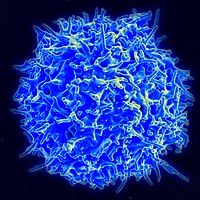
Photo from wikipedia
Background Adult T-cell leukemia/lymphoma (ATLL), a peripheral T-cell leukemia/lymphoma associated with the human T-cell lymphotropic virus type-1 (HTLV-1), has been classified following the clinical forms defined by Shimoyama in 1991.… Click to show full abstract
Background Adult T-cell leukemia/lymphoma (ATLL), a peripheral T-cell leukemia/lymphoma associated with the human T-cell lymphotropic virus type-1 (HTLV-1), has been classified following the clinical forms defined by Shimoyama in 1991. A suggestion to modify Shimoyama’s classification was proposed in 2007 to differentiate within the smoldering patients those who presented nodules or tumors in the skin without lung involvement, which was named the primary cutaneous tumoral (PCT) form of ATLL. In the present study, according to their clinicopathological characteristics, we estimated the mortality rates of 143 ATLL patients from Bahia, Brazil. We also evaluated the importance of classifying PCT/ATLL separately from the smoldering type on disease prognosis. Methodology/Principal findings Diagnosis of ATLL was established based on a positive serology for HTLV-1, histopathological and/or cytological diagnosis of peripheral T-cell leukemia/lymphoma. Patients were clinically grouped according to Shimoyama’s classification, considering PCT variants separately from the smoldering cases. Bivariate and multivariable survival analyses were applied to identify factors associated with disease prognosis. Significant differences in the median survival time were observed between the clinical types, with the smoldering type presenting the longest median survival (109 months) compared to the other forms (<50 months); the median survival for PCT/ATLL was 20 months. Multivariable analysis confirmed that ATLL clinical types were associated with survival, with a better prognosis for patients with the smoldering and chronic types. Furthermore, skin involvement was related to a worse outcome in the multivariable analysis, regardless of the clinical form and presence of lymphadenopathy. Conclusions/Significance Our results reinforce the importance of considering the PCT/ATLL separately from the smoldering type when classifying ATLL to better define prognosis and treatment, given the significant difference in the survival of patients between the smoldering form and PCT/ATLL. Skin involvement should also be considered an independent prognostic factor in patients with ATLL.
Journal Title: PLoS Neglected Tropical Diseases
Year Published: 2022
Link to full text (if available)
Share on Social Media: Sign Up to like & get
recommendations!